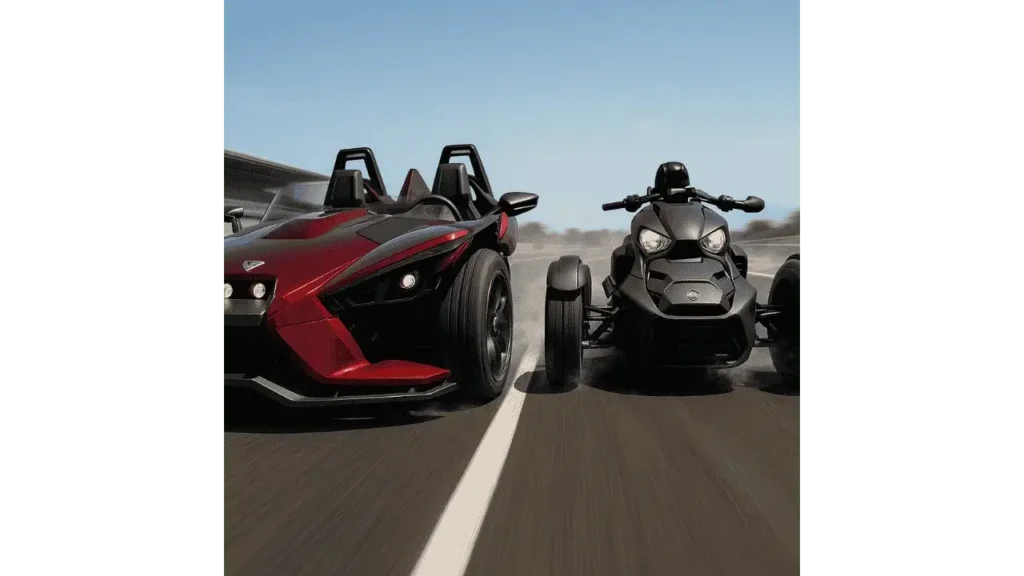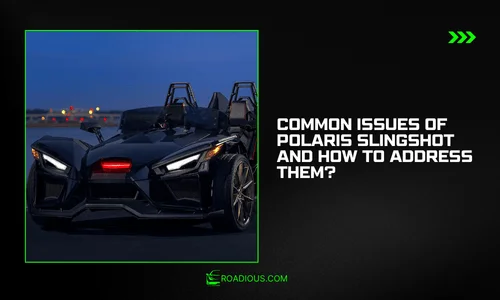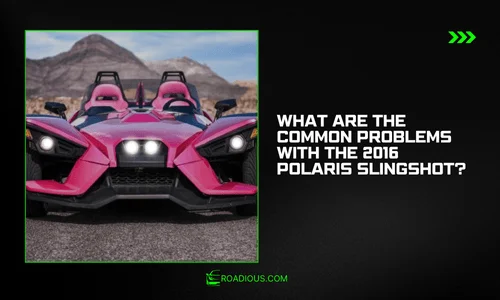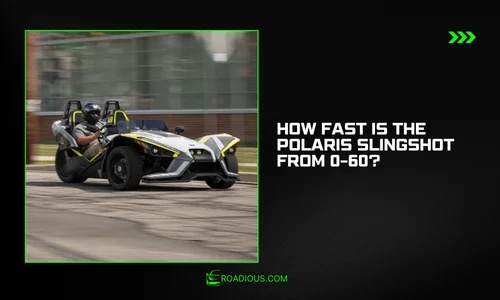When I first took the Polaris Slingshot for a weekend road trip through Vermont, the experience felt like strapping into something between a rocket and a go-kart. A few weeks later, I borrowed a Can-Am Ryker for a similar trip, and while it didn’t have the same aggressive bite, I finished the ride feeling relaxed, comfortable, and surprisingly impressed. These aren’t just showy three-wheelers. They each offer something real, depending on how and where you plan to ride. If you’re trying to decide between the Polaris Slingshot and Can-Am, it all comes down to design, power, comfort, and how well they fit into your everyday world.

Aesthetic Design and Road Presence
The Bold Statement of the Polaris Slingshot
The Polaris Slingshot grabs attention the moment it appears. Its futuristic, open-air cockpit and sharp body angles give it the feel of a performance machine designed for impact. You sit low, surrounded by minimal structure, feeling every breath of the road. If turning heads matters to you, the Slingshot never goes unnoticed. Its styling leans heavily into speed and spectacle, which makes every trip feel like a public event.
The Sleek Practicality of the Can-Am
In contrast, Can-Am’s design, especially in the Spyder and Ryker models, balances modern looks with more purpose-built details. It doesn’t try as hard to impress at first glance, but its form reflects a strong blend of function and elegance. I found the Ryker especially nimble through city traffic, its frame built with practicality in mind. For those who want style without sacrificing usability, Can-Am does a better job of keeping both in harmony.
Comparing Performance and Engine Feel
Slingshot’s Raw Power and Control
Under the hood, the Polaris Slingshot delivers an engine that sounds and feels like it belongs on a track. Its inline-four pumps out instant torque, and the steering is razor-sharp. On winding backroads, it rewards aggressive driving. I’ve taken it into tight curves and felt the rear tire grip with surprising confidence. As a driver-focused machine, the Slingshot caters to thrill-seekers who want a direct connection with the road.
Can-Am’s Refined Smoothness
Can-Am models, especially the Spyder F3, lean more into comfort and steady power delivery. The engines are built for long rides rather than sheer speed. Acceleration is smooth, and the automatic transmission makes cruising feel effortless. According to Powersports expert Aaron Heinrich,
“Can-Am’s Rotax engines are designed for efficiency and control rather than blistering speed” and you can feel that philosophy in every mile.
Comfort and Ride Experience
Exposed Adventure in the Slingshot
The open cockpit of the Slingshot offers no roof, no doors, and no compromises. You’re in the wind, and for some drivers, that’s the whole appeal. It comes with creature comforts like a modern touchscreen and Bluetooth, but it still feels raw. On colder or wetter days, you definitely feel the elements. For short thrill rides or sunny days, it’s hard to beat. But it’s not for everyone.
Read More: How Much is a 2023 Polaris Slingshot?
Long-Haul Comfort in the Can-Am
Can-Am shines when it comes to comfort. The seating position is upright and ergonomic, the handlebars adjustable, and the ride noticeably smoother over long distances. I rode for over three hours on the Ryker without feeling fatigued, which says a lot.
“Our goal is to make extended riding more accessible to all levels of riders,”
says Bernard Guy, Senior VP at BRP. That goal shows in every design choice they make.
Practicality and Ownership
Fuel and Maintenance
The Polaris Slingshot delivers a punchy drive but comes with a fuel economy of around 20–25 mpg. It’s a fair trade-off for performance, though maintenance requires regular attention, especially with heavier use. In contrast, Can-Am models are known for fuel efficiency, the Ryker averages about 40 mpg. They also come with a reputation for reliability, requiring less upkeep over time.
Customization Potential
Both Polaris and Can-Am offer extensive customization options. With Polaris, you can easily find body kits, audio upgrades, or lighting mods that turn your Slingshot into something truly personal. Can-Am isn’t far behind, with plenty of ergonomic and aesthetic upgrades, especially for touring-focused users. The real question is how much you want to tweak your ride, both brands let you go as deep as you want.
Learn More: Polaris Slingshot vs Can-Am Ryker: Which One Should You Choose?
Cost and Value
Polaris Pricing
Starting at around $20,000 for the base model and going up to $35,000 for the top trims, the Slingshot is definitely a high-ticket toy. But for those seeking high-adrenaline fun and standout design, the value is clear. You pay more for the show and the speed.
Can-Am Affordability
The Ryker starts at about $9,000, while Spyder models range from $15,000 to $25,000. That flexibility makes Can-Am accessible to more riders. The features-to-price ratio leans in its favor, especially if you want a machine that can handle both weekend rides and daily commutes with ease.
Final Takeaways
Choosing between the Polaris Slingshot and Can-Am really depends on how you want to ride. If you crave the rush of raw power, sharp design, and an open-air thrill, the Slingshot is a great match. If comfort, control, and everyday practicality matter more to you, Can-Am is the stronger option. Both are exciting, but in different ways. The best choice isn’t about which one looks cooler, it’s about which one fits your life.





